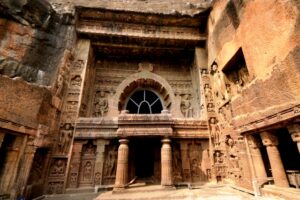
The Ajanta Caves are situated at a distance of 107 km north of Aurangabad, the district headquarters, Maharashtra. The caves attained the name from a nearby village named Ajanta located about 12 km. These caves were discovered by an Army Officer in the Madras Regiment of the British Army in 1819 during one of his hunting expeditions. Instantly the discovery became very famous and Ajanta attained a very important tourist destination in the world. The caves, famous for its murals, are the finest surviving examples of Indian art, particularly painting.
The site of Ajanta comprises thirty caves cut into the side of a cliff which rises above a meander in the Waghora River. Today the caves are reached by a road which runs along a terrace mid-way up the cliff, but each cave was once linked by a stairway to the edge of the water.
This is a Buddhist community comprising five sanctuaries or Chaitya-grihas (caves 9, 10, 19, 26 and 29) and monastic complex, sangharamas or viharas. A first group of caves was created in the second century B.C. : The chaitya-grihas open into the rocky wall by doorways surmounted by a horse-shoe shaped bay. The ground plan is a basilical one: piers separate the principal cave from the side aisles which join in the apsis to permit the ritual circumambulation behind the stupa (commemorative monument). This rupestral architecture scrupulously reproduces the forms and elements visible in wooden constructions.
A second group of caves was created at a later date, the fifth and sixth centuries A.D., during the Gupta and post-Gupta periods. The earlier architecture formulas were re-employed but treated in an infinitely richer and more ample manner. The decoration attained, at this time, an unequalled splendour. The statuary is numerous (it was already permissible to represent Buddha as a human, these representations are found both on the facades and in the interior,. Finally, the wall painting, profuse and sensitive, constitutes, no doubt, the most striking artistic achievement of Ajanta.
Under the Impulse of the Gupta dynasty, Indian art, in effect, reached its apogee. The Ajanta Caves are generally decorated with painted or sculpted figures of supple form and classic balance with which the name of the dynasty has remained synonymous. The refined lightness of the decoration, the balance of the compositions, the marvellous beauty of the feminine figures place the paintings of Ajanta among the major achievements of the Gupta and post-Gupta style and confer on them the ranking of a master piece of universal pictorial art.
Criterion (i): Ajanta is a unique artistic achievement
Criterion (ii): the style of Ajanta has exerted a considerable influence in India and elsewhere, extending, in particular, to Java
Criterion (iii): With its two groups of monuments corresponding to two important moments in Indian history I this rupestral ensemble bears exceptional testimony to the evolution of Indian art, as well as to the determining role of the Buddhist community, intellectual and religious foyers, schools and reception centres in the India of the Gupta and their immediate successors.
Criterion (vi): Ajanta is directly and materially associated with the history of Buddhism
Source:
http://whc.unesco.org/en/list/242
http://asi.nic.in/asi_monu_whs_ajanta.asp
http://www.wikiwand.com/en/Indian_rock-cut_architecture


